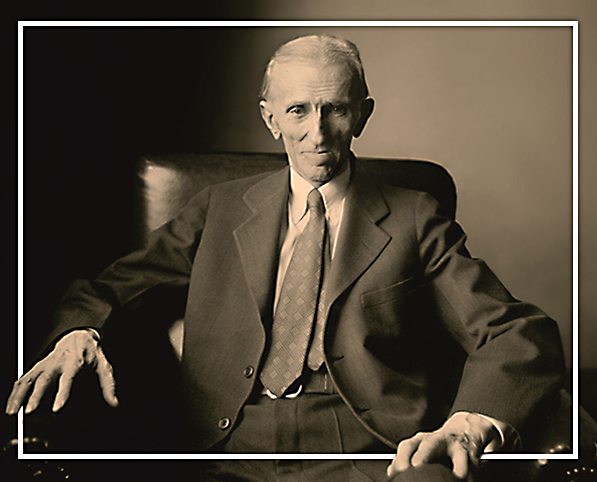GRADE LEVEL
Grades 9 through 12
ESTIMATED TIME
This lesson plan will take approximately 50 minutes.
CONCEPT
According to the Law of Conservation of Energy, we cannot create or destroy energy, but we can change its form. That means we can transmit energy great distances in its electrical form and, when it arrives at its destination, change it into its mechanical form to do work.
BACKGROUND
The most common device for changing electrical energy into mechanical energy is the motor. Most motors use electromagnets to cause mechanical rotation, which can do work. Before Nikola Tesla invented the AC (alternating current) induction motor, no motors could change AC into mechanical energy. The most fundamental element of the AC motor is the electromagnet, a magnet made from electric current. In the first Demonstration Experiment below, you can make and demonstrate an electromagnet to show students the most basic method of changing electrical energy into mechanical energy.
LESSON OBJECTIVES
Students will:
Discuss the idea that as mechanical energy was converted into electrical energy at the power plant, electric energy is now to be converted back to mechanical energy by a motor.
Make some simple drawings of how magnets work in the operation of a motor.
Discuss the use of the motor in industry and how other applications of the motor might work.
NATIONAL STANDARDS
This lesson addresses the following National Science Education Standards, found at http://www.nap.edu/readingroom/books/nses/:
Science as Inquiry: Scientists usually inquire about how physical, living, or designed systems function. Conceptual principles and knowledge guide scientific inquiries. Historical and current scientific knowledge influence the design and interpretation of investigations and the evaluation of proposed explanations made by other scientists.
Physical Science, Interactions of Energy and Matter: Electricity and magnetism are two aspects of a single electromagnetic force. Moving electric charges produce magnetic forces, and moving magnets produce electric forces. These effects help students to understand electric motors and generators.
Physical Science, Conservation of Energy: The total energy of the universe is constant. Energy can be transferred by collisions in chemical and nuclear reactions, by light waves and other radiations, and in many other ways. However, it can never be destroyed. As these transfers occur, the matter involved becomes steadily less ordered.
Physical Science, Interactions of Energy and Matter: All energy can be considered to be either kinetic energy, which is the energy of motion; potential energy, which depends on relative position; or energy contained by a field, such as electromagnetic waves.
Physical Science, Interactions of Energy and Matter: In some materials, such as metals, electrons flow easily, whereas in insulating materials such as glass they can hardly flow at all. Semiconducting materials have intermediate behavior. At low temperatures some materials become superconductors and offer no resistance to the flow of electrons.
Science and Technology: Science and technology are pursued for different purposes. Scientific inquiry is driven by the desire to understand the natural world, and technological design is driven by the need to meet human needs and solve human problems. Technology, by its nature, has a more direct effect on society than science because its purpose is to solve human problems, help humans adapt, and fulfill human aspirations. Technological solutions may create new problems. Science, by its nature, answers questions that may or may not directly influence humans. Sometimes scientific advances challenge people’s beliefs and practical explanations concerning various aspects of the world.
DEMONSTRATION EXPERIMENT:
CHANGE ELECTRICAL ENERGY INTO MECHANICAL ENERGY
Materials
Each student or each group of students will need the following materials to perform this experiment:
1-inch iron nail
100′ spool small-gauge insulated copper magnet wire (#25)
knife switch
4-inch iron nail
6-volt battery
small iron staples
paper clips or tacks
Procedure
View the illustrated instructions for a visual overview of this project.
Wrap the 4-inch nail with a coil of 25 to 50 turns of the wire. Connect one end of the coil to one terminal of the knife switch. Connect the other terminal of the knife switch to the battery. Connect the end of the coil to the other terminal of the battery. Hold the tip of the 1-inch nail near the flat end of the 4-inch nail.
Close the knife switch quickly and then open it. (Do not leave it closed.) What happens? (The 1-inch nail will be pulled toward the 4-inch nail. This is mechanical energy in action. The mechanical energy is caused by the attractive force of the electromagnet. Now imagine a circle of electromagnets that you could turn on and off one after another. Using this device, you could make the nail move in a circular pattern.)
Explore the World Outside
Ask students to list machines that use the spinning motion of motors to do work. Have students identify the kind of mechanical work done by the spinning parts of each of these machines. (A power lawnmower’s spinning blades cut grass; a car’s spinning wheels move the car down the street; a tape player’s spinning spool advances the audio or video tape)
Explore the Film and Web Site
Present related clips from the film Tesla: Master of Lightning to the class. The following are some suggestions:
04:30 – 11:41
My Early Years: Tesla’s early education
18:36 – 23:21
War of the Currents: The battle between Edison’s direct current and Tesla’s alernating current
23:21 – 27:40
Niagara: Overview of the first hydroelectric plant
After viewing clips from the film, ask students to write a report about the series of challenges that led young Nikola Tesla to his invention of the AC induction motor. How did Tesla take advantage of his opportunities and overcome obstacles to his success? How important to Tesla’s success was his science education? To find additional information on which to base this report, have students refer to the Life and Legacy area of this site.
What Do You Think?
Ask students to discuss what life might have been like before electric motors came into common use. What might your community have been like? To give students an idea of the enormity of Tesla’s contributions to the world, arrange a class outing to a historical museum to see how people lived and worked before Nikola Tesla conceived and designed the first long-distance power transmission system in 1895.
ASSESSMENT RECOMMENDATIONS
The teacher should consider the following when assessing students:
How well each student explained the idea of the motor in class discussion.
How did the students compare the operation of a simple electromagnet to the magnets working in a motor.
How well could students draw a diagram of an induction motor and explain the rotating magnetic field that makes it operate.
How well did class discussion show that the students understood not only the working of the motor but also the benefits of motors operating far away from power plants.
EXTENSIONS
Guide students through a discussion of what happens inside an electrical generator or dynamo. A coil of many turns of copper wire is rotated between the North and South poles of a very powerful magnet. As the rotating coil of wire passes one pole of the magnet, electrons in the wire are pushed in one direction. When the rotating coil of wire passes the other pole of the magnet, these electrons are pulled in the opposite direction. Because the electrical current keeps reversing direction, it is called alternating current.
https://www.pbs.org/tesla/tt/tt05.html

